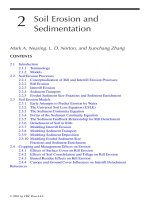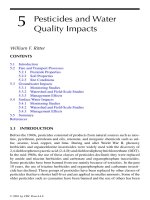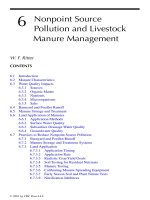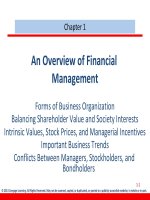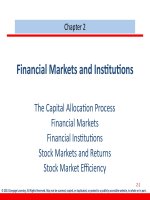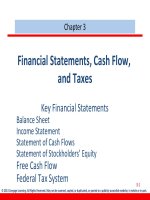Finance management cengage 2013 chapter 011
Bạn đang xem bản rút gọn của tài liệu. Xem và tải ngay bản đầy đủ của tài liệu tại đây (123.59 KB, 31 trang )
Chapter 11
The Basics of Capital Budgeting
Net Present Value (NPV)
Internal Rate of Return (IRR)
Modified Internal Rate of Return (MIRR)
Regular Payback
Discounted Payback
11-1
© 2013 Cengage Learning. All Rights Reserved. May not be scanned, copied, or duplicated, or posted to a publicly accessible website, in whole or in part.
What is capital budgeting?
•
•
•
Analysis of potential additions to fixed assets.
Long-term decisions; involve large expenditures.
Very important to firm’s future.
11-2
© 2013 Cengage Learning. All Rights Reserved. May not be scanned, copied, or duplicated, or posted to a publicly accessible website, in whole or in part.
Steps to Capital Budgeting
1.
Estimate CFs (inflows & outflows).
2.
Assess riskiness of CFs.
3.
Determine the appropriate cost of capital.
4.
Find NPV and/or IRR.
5.
Accept if NPV > 0 and/or IRR > WACC.
11-3
© 2013 Cengage Learning. All Rights Reserved. May not be scanned, copied, or duplicated, or posted to a publicly accessible website, in whole or in part.
What is the difference between independent
and mutually exclusive projects?
•
Independent projects: if the cash flows of one are
unaffected by the acceptance of the other.
•
Mutually exclusive projects: if the cash flows of one
can be adversely impacted by the acceptance of the
other.
11-4
© 2013 Cengage Learning. All Rights Reserved. May not be scanned, copied, or duplicated, or posted to a publicly accessible website, in whole or in part.
What is the difference between normal and
nonnormal cash flow streams?
•
Normal cash flow stream: Cost (negative CF)
followed by a series of positive cash inflows. One
change of signs.
•
Nonnormal cash flow stream: Two or more
changes of signs. Most common: Cost (negative
CF), then string of positive CFs, then cost to close
project. Examples include nuclear power plant,
strip mine, etc.
11-5
© 2013 Cengage Learning. All Rights Reserved. May not be scanned, copied, or duplicated, or posted to a publicly accessible website, in whole or in part.
Net Present Value (NPV)
•
Sum of the PVs of all cash inflows and outflows of a
project:
CFt
NPV = ∑
t
(
1
+
r
)
t=0
N
11-6
© 2013 Cengage Learning. All Rights Reserved. May not be scanned, copied, or duplicated, or posted to a publicly accessible website, in whole or in part.
Example
Projects we’ll examine:
Year
0
1
2
3
Cash Flow
L
S
-100
-100
10
70
60
50
80
20
∆CF
0
-60
10
60
∆CF is the difference between CFL and CFS. We’ll use
∆CF later.
11-7
© 2013 Cengage Learning. All Rights Reserved. May not be scanned, copied, or duplicated, or posted to a publicly accessible website, in whole or in part.
What is Project L’s NPV?
WACC = 10%
Year
0
1
2
3
CFt
-100
10
60
80
PV of CFt
-$100.00
9.09
49.59
60.11
NPVL = $ 18.79
Excel: =NPV(rate,CF1:CFn) + CF0
Here, CF0 is negative.
11-8
© 2013 Cengage Learning. All Rights Reserved. May not be scanned, copied, or duplicated, or posted to a publicly accessible website, in whole or in part.
What is Project S’ NPV?
WACC = 10%
Year
0
1
2
3
CFt
-100
70
50
20
PV of CFt
-$100.00
63.64
41.32
15.02
NPVS = $ 19.98
Excel: =NPV(rate,CF1:CFn) + CF0
Here, CF0 is negative.
11-9
© 2013 Cengage Learning. All Rights Reserved. May not be scanned, copied, or duplicated, or posted to a publicly accessible website, in whole or in part.
Solving for NPV:
Financial Calculator Solution
Enter CFs into the calculator’s CFLO register.
CF0 = -100
CF1 = 10
CF2 = 60
CF3 = 80
Enter I/YR = 10, press NPV button to get NPVL = $18.78.
11-10
© 2013 Cengage Learning. All Rights Reserved. May not be scanned, copied, or duplicated, or posted to a publicly accessible website, in whole or in part.
Rationale for the NPV Method
NPV = PV of inflows – Cost
= Net gain in wealth
•
If projects are independent, accept if the project
NPV > 0.
•
If projects are mutually exclusive, accept projects
with the highest positive NPV, those that add the
most value.
•
In this example, accept S if mutually exclusive
(NPVS > NPVL), and accept both if independent.
11-11
© 2013 Cengage Learning. All Rights Reserved. May not be scanned, copied, or duplicated, or posted to a publicly accessible website, in whole or in part.
Internal Rate of Return (IRR)
•
IRR is the discount rate that forces PV of inflows
equal to cost, and the NPV = 0:
CFt
0=∑
t
(1
+
IRR)
t =0
N
•
•
Solving for IRR with a financial calculator:
–
–
Enter CFs in CFLO register.
Press IRR; IRRL = 18.13% and
IRRS = 23.56%.
Solving for IRR with Excel:
=IRR(CF0:CFn,guess for rate)
11-12
© 2013 Cengage Learning. All Rights Reserved. May not be scanned, copied, or duplicated, or posted to a publicly accessible website, in whole or in part.
How is a project’s IRR similar to a bond’s YTM?
•
•
They are the same thing.
•
EXAMPLE: Suppose a 10-year bond with a 9%
annual coupon and $1,000 par value sells for
$1,134.20.
Think of a bond as a project. The YTM on the bond
would be the IRR of the “bond” project.
– Solve for IRR = YTM = 7.08%, the annual return for
this project/bond.
11-13
© 2013 Cengage Learning. All Rights Reserved. May not be scanned, copied, or duplicated, or posted to a publicly accessible website, in whole or in part.
Rationale for the IRR Method
•
If IRR > WACC, the project’s return exceeds its costs
and there is some return left over to boost
stockholders’ returns.
If IRR > WACC, accept project.
If IRR < WACC, reject project.
•
If projects are independent, accept both projects,
as both IRR > WACC = 10%.
•
If projects are mutually exclusive, accept S, because
IRRs > IRRL.
11-14
© 2013 Cengage Learning. All Rights Reserved. May not be scanned, copied, or duplicated, or posted to a publicly accessible website, in whole or in part.
NPV Profiles
•
A graphical representation of project NPVs at
various different costs of capital.
WACC
0
5
10
15
20
NPVL
$50
33
19
7
(4)
NPVS
$40
29
20
12
5
11-15
© 2013 Cengage Learning. All Rights Reserved. May not be scanned, copied, or duplicated, or posted to a publicly accessible website, in whole or in part.
Independent Projects
NPV and IRR always lead to the same accept/reject
decision for any given independent project.
NPV ($)
IRR > r
and NPV > 0
Accept.
r > IRR
and NPV < 0.
Reject.
r = 18.1%
IRRL = 18.1%
r (%)
11-16
© 2013 Cengage Learning. All Rights Reserved. May not be scanned, copied, or duplicated, or posted to a publicly accessible website, in whole or in part.
Mutually Exclusive Projects
If r < 8.7%: NPVL > NPVS
IRRS > IRRL
CONFLICT
NPV
L
If r > 8.7%: NPVS > NPVL ,
IRRS > IRRL
NO CONFLICT
S
r
8.7
%
r
IRRL
IRRs
11-17
© 2013 Cengage Learning. All Rights Reserved. May not be scanned, copied, or duplicated, or posted to a publicly accessible website, in whole or in part.
Finding the Crossover Rate
•
Find cash flow differences between the projects.
See Slide 11-7.
•
Enter the ∆CFs in CFj register, then press
IRR. Crossover rate = 8.68%, rounded to 8.7%.
•
If profiles don’t cross, one project dominates the
other.
11-18
© 2013 Cengage Learning. All Rights Reserved. May not be scanned, copied, or duplicated, or posted to a publicly accessible website, in whole or in part.
Reasons Why NPV Profiles Cross
•
Size (scale) differences: the smaller project frees up
funds at t = 0 for investment. The higher the
opportunity cost, the more valuable these funds, so
a high WACC favors small projects.
•
Timing differences: the project with faster payback
provides more CF in early years for reinvestment. If
WACC is high, early CF especially good, NPVS > NPVL.
11-19
© 2013 Cengage Learning. All Rights Reserved. May not be scanned, copied, or duplicated, or posted to a publicly accessible website, in whole or in part.
Reinvestment Rate Assumptions
•
NPV method assumes CFs are reinvested at the
WACC.
•
•
IRR method assumes CFs are reinvested at IRR.
•
Perhaps a hybrid of the IRR that assumes cost of
capital reinvestment is needed.
Assuming CFs are reinvested at the opportunity cost
of capital is more realistic, so NPV method is the
best. NPV method should be used to choose
between mutually exclusive projects.
11-20
© 2013 Cengage Learning. All Rights Reserved. May not be scanned, copied, or duplicated, or posted to a publicly accessible website, in whole or in part.
Since managers prefer the IRR to the NPV method, is
there a better IRR measure?
•
Yes, MIRR is the discount rate that causes the PV of
a project’s terminal value (TV) to equal the PV of
costs. TV is found by compounding inflows at
WACC.
•
MIRR assumes cash flows are reinvested at the
WACC.
11-21
© 2013 Cengage Learning. All Rights Reserved. May not be scanned, copied, or duplicated, or posted to a publicly accessible website, in whole or in part.
Calculating MIRR
0
10%
-100.0
1
2
3
10.0
60.0
80.0
10%
-100.0
PV outflows
10%
66.0
12.1
158.1
MIRR = 16.5%
$158.1
$100 =
(1 + MIRRL)3
MIRRL = 16.5%
TV inflows
Excel: =MIRR(CF0:CFn,Finance_rate,Reinvest_rate)
We assume that both rates = WACC.
11-22
© 2013 Cengage Learning. All Rights Reserved. May not be scanned, copied, or duplicated, or posted to a publicly accessible website, in whole or in part.
Why use MIRR versus IRR?
•
MIRR assumes reinvestment at the opportunity cost
= WACC. MIRR also avoids the multiple IRR
problem.
•
Managers like rate of return comparisons, and MIRR
is better for this than IRR.
11-23
© 2013 Cengage Learning. All Rights Reserved. May not be scanned, copied, or duplicated, or posted to a publicly accessible website, in whole or in part.
What is the payback period?
•
The number of years required to recover a project’s
cost, or “How long does it take to get our money
back?”
•
Calculated by adding project’s cash inflows to its
cost until the cumulative cash flow for the project
turns positive.
11-24
© 2013 Cengage Learning. All Rights Reserved. May not be scanned, copied, or duplicated, or posted to a publicly accessible website, in whole or in part.
Calculating Payback
Project L’s Payback Calculation
0
1
2
3
CFt
-100
10
60
80
Cumulative
-100
-90
-30
50
PaybackL = 2 + 30 / 80
= 2.375 years
PaybackS = 1.600 years
11-25
© 2013 Cengage Learning. All Rights Reserved. May not be scanned, copied, or duplicated, or posted to a publicly accessible website, in whole or in part.
